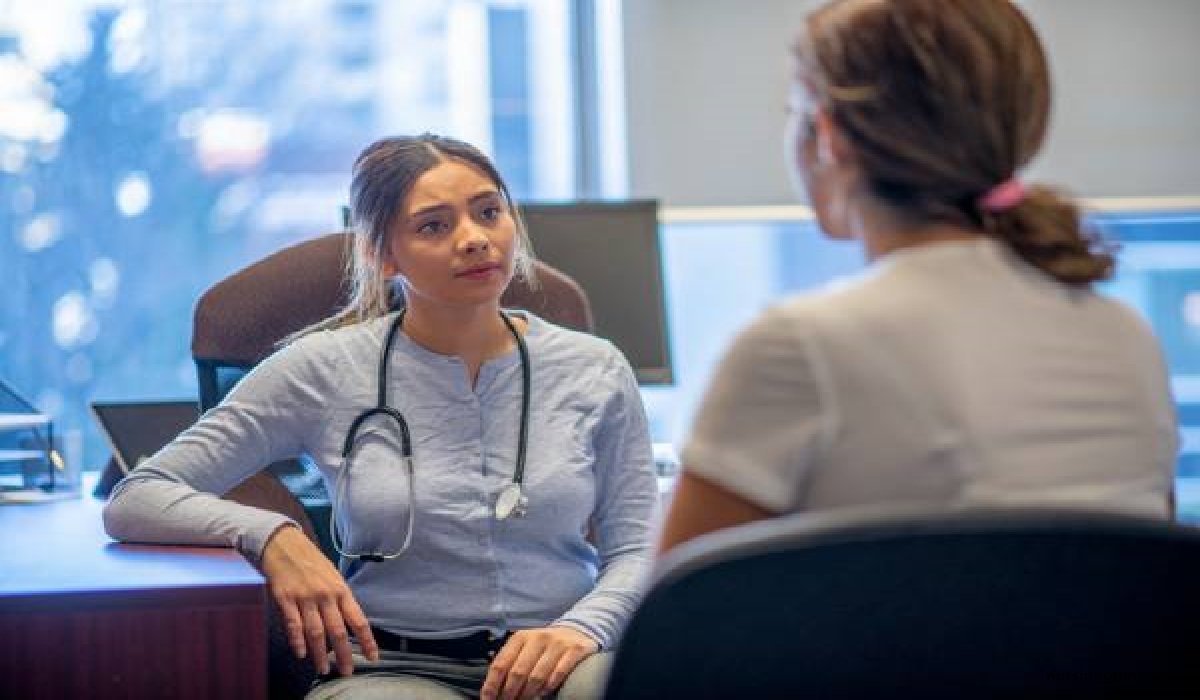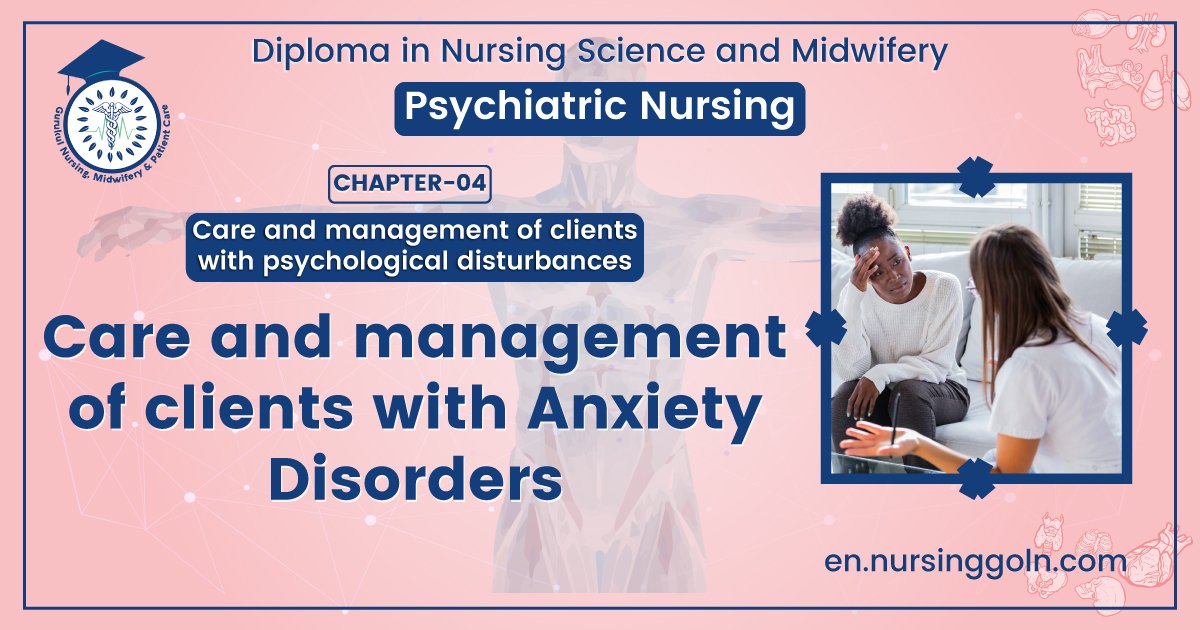Care and management of clients with Anxiety disorders – This book covers the entire syllabus of “Psychiatric Nursing” prescribed by the Universities of Bangladesh- for Basic and diploma nursing students. We tried to accommodate the latest information and topics. This book is an examination-friendly setup according to the teachers’ lectures and examination questions.
At the end of the book previous university questions are given. We hope in touch with the book students’ knowledge will be upgraded and flourish. The unique way of presentation may make your reading of the book a pleasurable experience.

Care and management of clients with Anxiety disorders
Anxiety:
Anxiety is a motivating force to an intrapsychic urge and a certain minimum level of anxiety improves performances in many situations.
Or
[Ref: S Nambi/24/52)
Anxiety is a normative pattern of human emotion; it will be experienced in varying degrees as a state of emotional or physical uneasiness.
(Ref: KP Neeraja/1″/Vol-2/418)
Anxiety disorder:
Anxiety is the basic symptom of many neurotic disorders. Anxiety disorders are psychological disturbances where anxiety is the essential symptom.
[Ref: S Nambi/2/52)
Or
‘Anxiety disorder is characterized by recurrent, unwanted thoughts (obsessions) or rituals (compulsions) which feel uncontrollable to the sufferer’.
[Ref: KP Neeraja/T/Vol-2/418]
Causes of anxiety disorder:
1. Exact cause is unknown.
2. Traumatic experiences.
3. Stimulation of autonomic nervous system and central nervous system
4. Genetic component, e.g. higher frequency of illness was observed in first degree relatives of affected persons than in the relatives of non-affected persons and in monozygotic twins
5. Socio-cultural factors, e.g. faulty child rearing practices
6. Psychological factors-maladaptive responses, strained interpersonal relationship, stress, unresolved conflicts, disturbing memories, forbidden impulses, conflict between id and ego.
7. Neurotransmitters and biochemical factors:
- Alpha-adrenergic agonists and alpha-2 adrenergic antagonist can produce frequent and severe panic attacks.
- Serotonergic hallucinogens and stimulants, e.g. lysergic acid diethylamide (LSD) and 3, 4 methylene dioxymethamphetamine (MDMA) are associated with the development of both acute and chronic anxiety disorders
- Alteration in GABA levels
- Increased levels of norepinephrine, serotonin.
8. Behavioural factor:
- Unconditional inherent response of the organism to painful stimuli
9. Cognitive factor: Cognitive distortions; negative automatic thoughts.
10. Medications and substances which can induce anxiety are: caffeine and other stimulants, drugs, e.g. heroin, cocaine and amphetamines, decongestants, steroids, e.g. cortisone, weight loss products, and hormonal pills, withdrawal from alcohol or benzodiazepines.
(Ref: KP Neeraja/1/Vol-2/420)
Classification of anxiety disorder:
1. Generalized anxiety disorder.
2. Phobic anxiety disorder
3. Panic disorder
4. Obsessive-compulsive disorders.
[Ref-Davidson’s/241
According to ICD-10
1. Phobic anxiety disorders:
- Agoraphobia
➤ Without panic disorder
➤ With panic disorder
- Social phobias
- Specific (isolated) phobias
- Other phobic anxiety disorders
- Phobic anxiety disorder, unspecified
2. Other anxiety disorders:
- Panic disorder (episodic) paroxysmal anxiety
- Generalized anxiety disorder
- Mixed anxiety and depressive disorder
- Other mixed anxiety disorders
- Other specified anxiety disorders
- Unspecified anxiety disorders
3. Obsessive compulsive disorder
- Predominantly obsessional thoughts or ruminations
- Predominantly compulsive acts
- Mixed obsessional thoughts and acts
[Ref: KP Neeraja/1/Vol-2/416)
Assessment of anxiety:
1. Blood pressure increase.
2. Tachycardia.
3. Dilated pupil.
4. Sweating.
5. Muscular activity increase.
6. Increase hormonal level like- epinephrine, GH, cortisol.

Clinical features of anxiety disorder:
A. Physical Symptoms:
1. Cardiovascular system
➤ Tachycardia
➤ Chest pain
➤ Palpitations
➤ Dropped beats
➤ Flushing
➤Fainting
➤Respiratory system
➤ Sighing
➤ Choking
➤ Yawning
➤ Dyspnea
2. Alimentary system
➤ Dry mouth
➤ Dysphagia
➤ Dyspepsia
➤ ‘Butterflies’ in stomach
➤ Nausea
➤ Abdominal pain
➤ Diarrhea
3. Genitourinary system
➤ Frequency
➤ Hesitation
➤ Sexual dysfunction
4. Nervous system
➤ Tension headaches
➤ Blurring of vision
➤ Tinnitus
➤ Sweating
➤ Tremor
➤ Dilated pupils
5. Musculoskeletal system
➤ Aches and pain
➤ Teeth clenching
➤ Chronic jerks.
B. Psychological Symptoms of Anxiety:
1. Anxious mood (Feeling of something terrible about to happen)
2. Worry or fear
3. Irritability
4. Inability to relax
5. Feeling of being unable to cope
6. Feeling restless
7. Depersonalization
8. Derealization
9. Initial insomnia
10. Nightmares.
[Ref: S Nambi/24/53-541

Types of Anxiety:
1. Separation Anxiety;
It occurs in people who have the fear, the loss of love or even abandonment by their parents, if the child fails to control their impulses in conformity with their parent standards and demands, when a child is separated from parent or away from home.
2. Castration Anxiety:
The castration fantasies of oedipal child in relation to child’s developing sexual impulses.
3. Existential Anxiety:
Philosophical ruminations are a part of this condition, a part of obsessive compulsive disorder, anxiety is related to sex, religion and death.
4. Test Anxiety:
The uneasiness, apprehension or nervousness felt by students who have a fear of failing exam. Students suffering from test anxiety may experience embarrassment by the teacher, fear of alienation from parents or friends, time pressure or feeling a loss of control, emotional cognitive, behavioural and physical components.
5. Stranger Anxiety:
Anxiety while meeting or interacting with unknown people.
6. Anxiety in Palliative Care:
Clients with chronic disorders (cancer, heart disease, etc.) will have anxiety about the disease prognosis; to improve the quality of life and to lessen the fear.ociated with it, the services of counselling, relaxation techniques and drug therapy, e.g benzodiazepines, ete, will be provided.
7. Generalized Anxiety Disorders/Free Floating Anxiety
Persistent, chronic generalized anxiety, most common form, experienced mostly by women.
8. Social Anxiety/Social Phobia:
A debilitating fear of being seen negatively by others and humiliated in public. Social phobia results, it may be extremely shyness. In severe cases, social situations are avoided all together, e.g. performance anxiety.
[Ref: KP Neeraja/1″/Vol-2/422-423]
Treatment of anxiety disorders:
1. Evaluation of the patient’s symptoms.
2. Detailed history.
3. Understanding the relationship between symptoms and life events.
4. Determination of a treatment plan.
Drug Treatment in Anxiety Disorders:
| Benzodiazepines-Diazepam | 5-15 mg/day |
| Chlordiazepoxide | 10-30 mg/day |
| Clonazepam | 0.5-2 mg |
| Alprazolam | 0.5-3 mg/day |
| Lorazepam | 1-3 mg/day |
| Flurazepam | 10-30 mg/day |
| Buspirone | 10-30 mg/day |
| Beta blocker | 20-120 mg/day |
Psychological Methods of Treatment
1. Explanation
2. Reassurance
3. Crisis intervention
4. Supportive psychotherapy
5. Relaxation exercises
6. Group therapy
7. Yoga and meditation.
[Ref: S Nambi/24/55-561

Nursing management of anxiety disorder:
1. Explain to the patient and relatives that the symptoms are not due to any physical disease but due to a mild psychological problem which can be effectively treated.
2. Reassure the patient that many people have similar problems, it is short lived and can be managed effectively.
3. Be supportive to the patient and to the relatives.
4. Patient develops a feeling of security in the presence of a calm and tactful nurse.
5. Patients suffering from panic disorders may fear for his or her life, and need support and reassurance.
6. Keep the surrounding low in stimuli (dim lighting, few people). A stimulating environment may increase the level of anxiety.
7. The nurse should identify the precipitating factor and educate the patient to avoid it.
8. Help the patient understand the benefit of relaxation in anxiety provoking situation and teach them simple relaxation techniques, deep breathing exercises, physical exercise like a brisk walk, yoga & meditation and so on. A relaxed body will help to relax the mind.
9. It is important for a nurse to understand the patient’s fear and help him or her to reduce it.
10. The nurse should educate the patient to accept the reality.
11. The nurse should understand the ineffective coping in anxiety disorder and teach the patient better coping strategies.
12. Especially in OCD, positive reinforcement enhances self-esteem and encourages repetition of desired behavior. Anxiety is minimized when the patient is able to replace ritualistic behavior with more adaptive ones.
13. It is essential for the nursing care to encourage patients with anxiety disorder to take care of their own activities without much assistance.
14. Patient’s comfort and safety are nursing priorities.
15. The nurse dealing with an anxiety disorder patient should be careful in not allowing the patient become dependent on the nursing staff.
(Ref: S Nambi/2/63-641)
Generalized Anxiety Disorder
It is characterized by abnormal state which have the physical and mental symptoms of anxiety as their main clinical features and which are not secondary to organic brain disease or to another psychiatry disorders.
Or
This is chronic anxiety associated with uncontrollable worry. Somatic symptoms of muscle tension and bowel disturbance often lead to a medical presentation.
[Ref-Davidson/21/241)
Or
Generalized anxiety disorder is defined as excessive anxiety and worry for 6 months or longer accompanied by some somatic symptoms. The anxiety is difficult to control and causes significant impairment / in social and occupational functioning.
[Ref-A.K. Moyeenuddin Ahimned/1/16]
Clinical features of generalized anxiety disorder:
All the symptoms of anxiety can occur in generalized anxiety disorder (GAD) but there a characteristic pattern comprised of the following features:
✓All the symptoms of anxiety (Please see the above).
✓ Worry and apprehension.
✓Muscle tension.
✓ Autonomic over activity.
✓Psychological arousal.
✓ Sleep disturbance.
✓Other features:
- Depression.
- Obsessions.
- Depersonalization.
[Ref-Michael Gelder/5/177)
Clinical signs of generalized anxiety disorder:
1. The face appears stained.
2. Night terror.
3. The posture is tense.
4. Restless and tremble.
5. Skin pale and sweating specially hands, feet and axillae. (Palm cold and wet).
6. Readiness to tears, which may at first suggest depression.
7. Reflects the generally apprehensive state.
[Ref-Michael Gelder/9/178)
Differential diagnoses of GAD:
1. Schizophrenia
2. Depression
3. Dementia
4. Substance misuse
5. Medical conditions:
6. Hypoglycemia
7. Hyperthyroidism
Treatment of GAD:
A. Psychological:
1. Reassurance & explanation.
2. Psychotherapy – Individual, cognitive (in panic attack), behavior therapy (in phobic anxiety).
- Relaxation techniques:
- Regular mild exercise
- Meditation
- Hypnosis.
- Praying
3. Behaviour therapy with desensitization in phobic anxiety.
B. Physical/Somatic:
Drugs-
a. Anxiolytic: Benzodiazepine -Used for short term
- Diazepam.
- Clobazam
- Bromazepam
- Clonazepam,
- Alprazolam
b. Antidepressants: is the drug of choice
- Amitryptyline
- Nortryptyline
- Fluoxetine
- Phenelzine
c. beta-blockers: For somatic symptoms
- Propranolol
[Ref-Davidson’s edition)
Anxiety Neurosis
It is characterized by abnormal state which has the physical and mental symptoms of anxiety as their main clinical features and that are not secondary to organic brain disease or to another psychiatry disorders.
[Ref-Davidson’s/24th edition)
Classification of anxiety neurosis:
1. Generalized anxiety disorder
2. Specific anxiety disorder
3. Panic disorder
4. Acute & post-traumatic stress disorder
5. Phobic anxiety disorder
6. Agora phobia.
7. Simple phobia
8. Social phobia
9. Obsessive compulsive disorder.
Causes of anxiety neurosis:
A. Biological and environmental factors together contribute neurosis:
1. Faulty socialization
2. Defective role models
3. Low socioeconomic status
4. Low educational status
B. Psychological factors:
1. Maladaptive learning or defective learning
2. Threatening inner desires and impulses 3. Lack of stimulating environment
4. Strained or distorted interpersonal relationship
5. Stressful environment.
Clinical features of anxiety neurosis:
A. Somatic manifestation:
1. Dyspnoea sneezing
2. Tension headache, fatigue
3. Insomnia, sleep disturbances
4. Anorexia
5. Nausea and vomiting
6. Chest pain or tightness in chest
7. Hypertension
8. Increased heart rate palpitations
9. Increased sweating or perspiration
10. Increased blood flow to the major muscle groups
11. Immune and digestive system functions are inhibited
12. Pale skin
13. Trembling, twitching and tremors
14. Pupillary dilatation
15. Chills or hot flashes
16. Tightness of neck or back muscles
17. Urinary frequency
18. Diarrhoea
19. Poor posture
20. Frequent minor illness
21. Accident proneness
22. Headache
23. Fatigue
24. Cold and clammy hands
25. Stomach upset or uneasiness
26. Shortness of breath
27. Dizziness
28. Muscle tension or aches.
B. Emotional manifestations of anxiety:
1. A sense of dread or panic
2. Nervousness and jumpiness
3. Self-consciousness
4. Insecurity
5. Fear of going to die or going crazy
6. Strong desire to escape or avoidance, hyper vigilance, confusion
7. Angry outburst
8. Suspiciousness
[Ref: KP Neeraja/1″/Vol-2/420)

Nursing management of anxiety neurosis:
| Nursing diagnosis | Goal | Intervention | Evaluation |
| Inadequate coping strategy related to fear for specific stimuli | Utilizes adequate coping strategies to overcome fear and faces the stimuli without fear or phobia. | Approach the client in a friendly manner, establish and maintain therapeutic nurse-“patient relationship. Be brief and firm. Motivate the client to ventilate his” feelings openly, during ventilation process nurse will act as an active listener, and try to explore the stressor, observe the clients’ covert anxiety. Clarify the doubts of the client. Demonstrate the adequate coping strategies, assist the client to utilize them successfully and appreciate the client, if he does so. Encourage the client to use behaviour modification techniques to cope up the situation, e.g. systematic desensitization, flooding, implosion, therapy, modelling, positive reinforcement etc. Assist the client to improve thinking process in a realistic manner and able to tolerate the anxiety provoking stimuli, let the client to develop control over situation. e.g. cognitive techniques. | Decrease fear and increase coping strategy |
| Perceptual disturbances related to anxiety | Improves perception, attention and concentration | Orient the client to the environment Encourage the client to perform some interested activities by paying attention and interest in completing the activity, motivate to get efficiency in itmitate Ask the client to observe for any distractions or hearing any sounds and ask them to inform to the health professional Motivate the client to concentrate in diversional activities Educate the client along with written material viz., self help skills, relaxation skills, which promotes the clients’ mind to have clear mind If the client does approved behaviour, reinforce him to perform it efficiently | Perception and attention improves. |
| Impaired communication related to anxiety and associated feelings | Enhances communication and achieves good socialization skills | Provide psychological support and reassurance to the client Provide calm and quiet (non stimulating/non disturbing/non- threatening) environment Motivate the client to utilize Provide psychological support and reassurance to the client Provide calm and quiet (non stimulating/non disturbing/non- threatening) environment Motivate the client to utilized He brief, use simple language Assist the client to establish good relationship with family members, friends and relatives Allow the client to perform the group activities Educate the client to have patience/tolerance in communicating Reduce the distraction in the environment Motivate the client to communicate with other group members in society to develop socialization skills | Improve communication ability |
| Experiences post traumatic experiences | Accepts, understands and adopts to the situation | Encourage the client to ventilate the traumatic events openly Provide supportive, trusting environment Assist the client to explore the stressors Demonstrate deep breathing, relaxation exercises, adequate coping strategies and encourage them to utilize it, and thereby handles the anxiety provoking situations Motivate the client to develop healthy habits, e.g. adequate nutrition, regularf sleep and rest, exercises, utilization of adequate coping strategies, etc. | Improve adaptability |
Read more:
